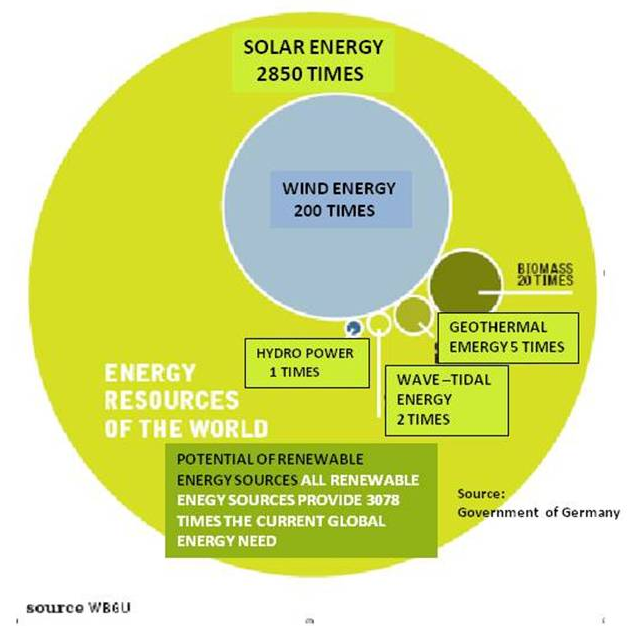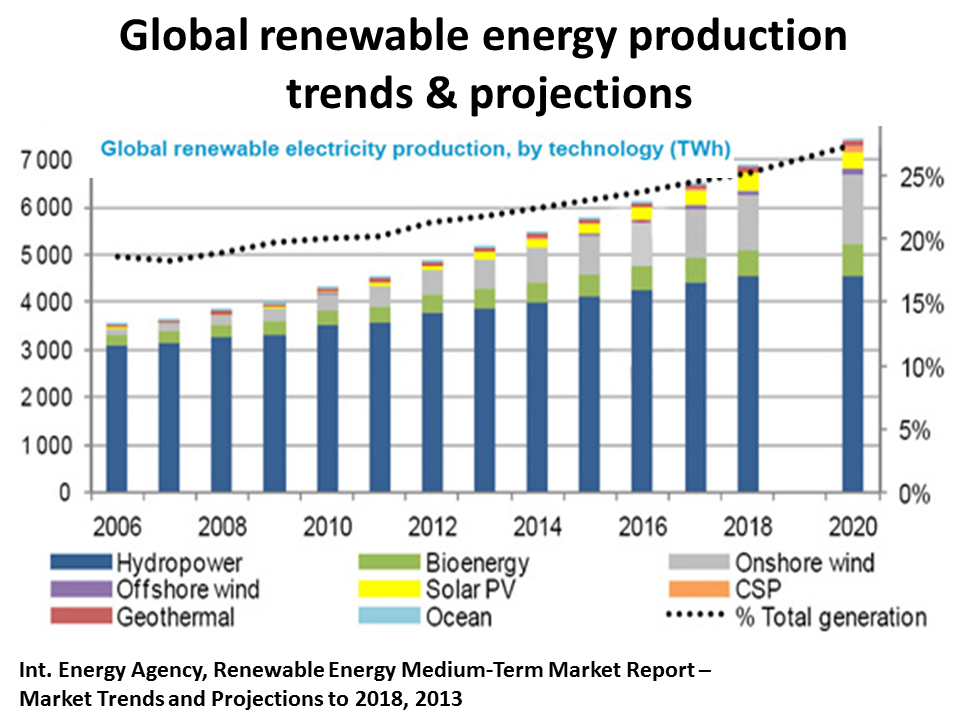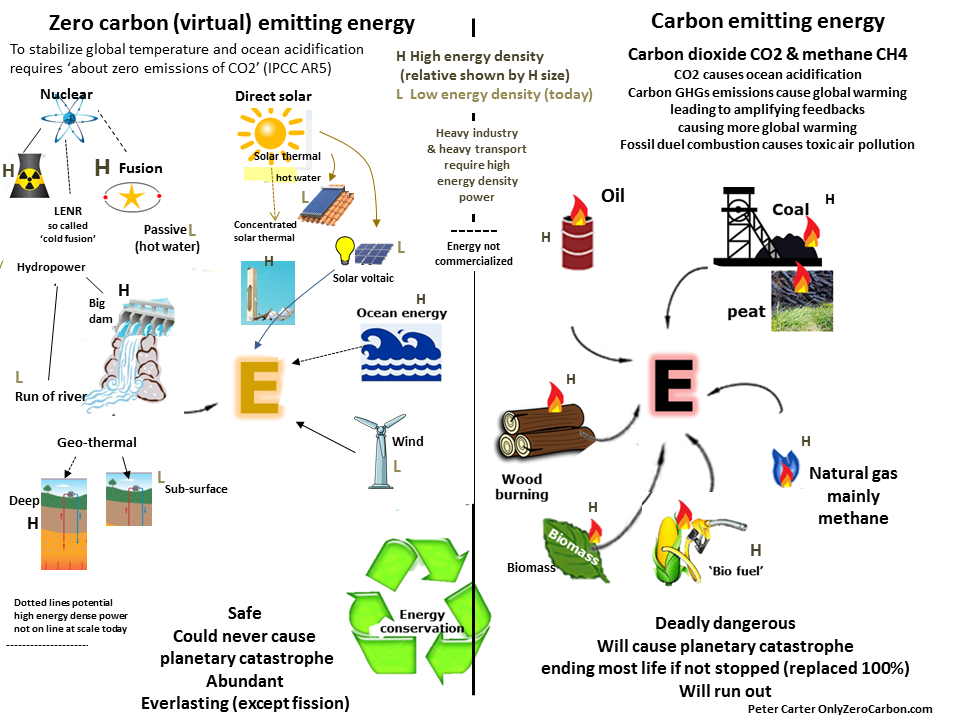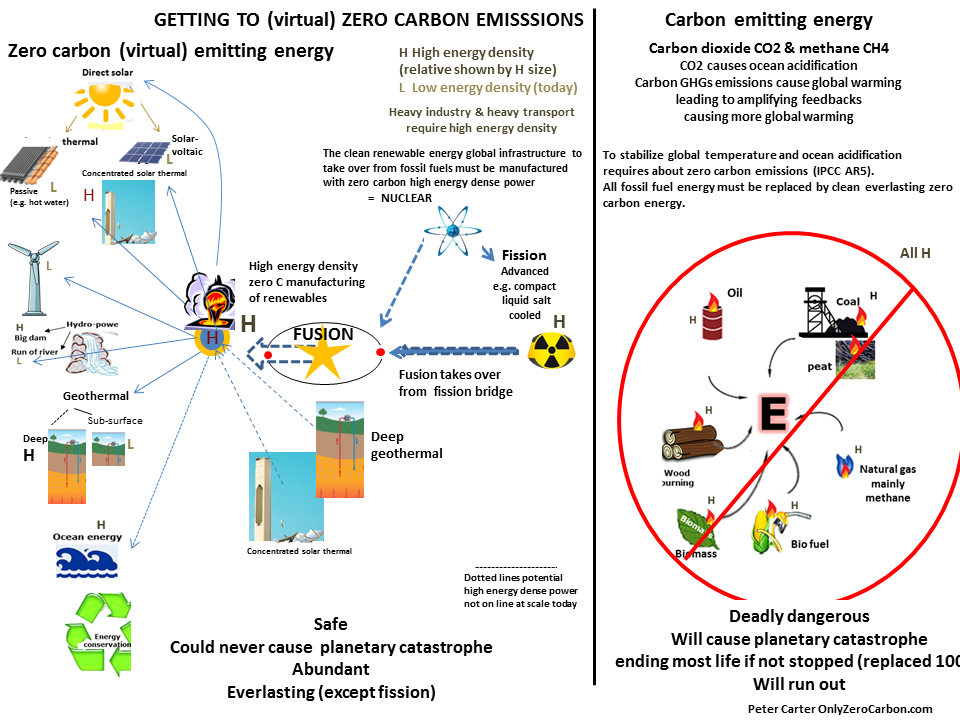ONLY ZERO CARBON ONLY ZERO CARBON ONLY ZERO CARBON ON LY ZERO CARBON ONLY ZERO CARBON ONLY ZERO
Though it is natural to think first of renewable energy, first off we have to stop CO2 emissions from deforestation and from agriculture- which has for long followed forest clearing.
Deforestation is the source of 15% of our CO2 emissions.
Agriculture is the source of one third of global GHG emissions.
The are many known sources of zero carbon clean energy :
-certain large dam hydro (those that do not emit methane)
-run of the river hydro and micro-hydro
-solar thermal
-solar voltaic
-wind
-geothermal underground and ultra deep energy dense
-heat pump geothermal
(includes water bodies)
-wave energy
-tidal energy
-? space solar power
Global renewable energy production has been increasing at a slightly accelerating rate which is projected to continue.
Clean new renewable energy still only makes up a very small proportion of world energy.
The costs of renewable energyis declining.
Global renewable energy investment has been rising fast.
Energy Storage
To further increase the growing available renewable energy energy storage is needed, because of the variable output from wind and solar. The technology is coming.
The nuclear power controversy
There is many times more than enough clean renewable energy to power the world, so why use nuclear?
Though theoretically possible renewable energy has not been developed to the stage of high intensity energy on which our civilization depends, with the potential exception of ultra deep geothermal.
As Prof. James Lovelock has said for many years with political will lacking to replace fossil fuel energy with today's renewables, advanced safer nuclear energy is our best chance, but with public opposition to nuclear fusion- we have to see if n nuclear fission energy can be developed and in time.
Where is all the concentrated energy going to come from to rebuild the world energy sources and infrastructure/ The only choice is fossil fuels or nuclear - so we do need more nuclear energy.
The counties that have performed best in terms of GHG gas emission have developed the most nuclear energy capacity like France Sweden. There is no justification in closing existing nuclear power plants as in happening in Germany and Japan.
We do not have concentrated renewable energy yet- that can happen with more research and development, but is not being made to happen.
Nuclear energy is a zero carbon energy source. While it takes fossil fuel energy to manufacture nuclear power plants, that applies to all energy development, and only nuclear energy can be manufactured from the same zero carbon power. Today all the other zero carbon energy infrastructure (wind, solar, tidal) is manufactured using fossil fuel energy and it's mainly coal.
There is no comparison between the health hazards of nuclear energy generation and continued fossil fuel energy generation which James Hansen addressed in a 2013 paper Coal and Gas are Far More Harmful than Nuclear Power
Nuclear power generation does not emit carbon dioxide as a consequence of energy generation. Although the opposition to nuclear energy in general has blocked their construction, improved generations of nuclear energy especially small-scale nuclear energy generators emit very much less carbon dioxide in construction and they are also far safer.
Obviously the idea decommissioning existing nuclear energy plants unless an individual plant is found to be 'unsafe to operate' makes no sense when we face global climate catastrophe. Even so as of June 2011, Germany and Switzerland are phasing-out nuclear power, which will be replaced mostly by fossil fuels, and a smaller part renewable energy.
The longer running a nuclear energy plant stays in operation the less is the carbon footprint of the power plants lifetime. If the nuclear energy plant is taken out of commission on the basis of public attitude and the large amount of energy is replaced by coal-fired energy a large amount of zero carbon energy has been replaced by the highest carbon emitting source of energy. The last word is that there is no risk of nuclear energy generation destroying civilization, ending humanity and ending most life on Earth. Continuing with coal-fired generation will most certainly do that.
CCS is not decarbonization as well as not net carbon -ve because at best it cannot work for much carbon or for long.
Carbon capture & storage (CCS) is not being promoted as a zero carbon technology.
For years it has been promoted as global climate solution by the fossil fuel industry- especially the coal industry. It is a fossil fuel boondoggle, because after many years of big investments it not getting anywhere (see 2013 report), and it is impossible to store the constant massive global global carbon emissions from combustion and do so permanently.
To enable any reduction of today's catastrophic concentration of atmospheric carbon dioxide and the long-term stabilization of atmospheric carbon dioxide, the science of zero carbon emissions demands a total replacement of all fossil fuel energy by clean zero carbon and everlasting energy. In a word conversion of the world's energy supply.
For the past 30 years non-governmental organisations and periodically governments have promoted the conservation of energy, which obviously must happen- big time.
Unfortunately at the same time is the promotion of ever more larger fossil fuel energy consuming technologies.
Energy conversion conservation have made little progress, even though all the methods to do so have been available for a time.
The prevailing approach to reduce carbon emissions is the reduction in carbon intensity, which is an energy conservation relying on energy efficiency approach.
But it is impossible to achieve zero carbon no matter how successful we are in improving fossil fuel energy efficiency. What in actual fact has been happening as a result of increasing is that global emissions have increased great carbon intensity. this is because improving carbon intensity has no effect on globalization fossil fuel energy and technologies that use fossil fuel energy.
So we have to have to do both conservation of energy and conversion of energy.
Energy Sources Net-zero with zero fossi fuels
WOOD. Highest CO2 emitting construction is the now universal steel and concrete. This can be replaced by wood construction that can sinks carbon for centuries.
TED Talk Why we should build wood skyscapers
TEDX Talk Bamboo Future
Net carbon negative
Science has established we have to achieve a net carbon negative world economy, and there are nature based options that we can and must do.
Forests -
The conversion of forested land to agricultural land results in a loss of carbon uptake storage.
It is generally believed that we can take carbon dioxide out of the atmosphere by planting more forests. Unfortunately for the prevention of global climate catastrophe, this is a temporary solution that can buy us vital time. To do so the forestation has to be with long lasting trees to be left permanently. The carbon cycle teaches us that the terrestrial carbon cycle involves photosynthesis of green plants taking carbon dioxide out of the atmosphere. Fixing it as carbon for energy use and plant growth (and in the process releasing oxygen to the air). But this is just one half of the carbon cycle - the other half occurs when plants decay and die and then the carbon is returned to the atmosphere as carbon dioxide. Over the long term the carbon is just recycled. Forests do not sink carbon permamently except by becoming fossil carbon (fuels).
Soil
Soil carbon uptake provides a great opportunity to increase carbon storage.Despite the much larger size of the oceanic carbon pool relative to the soil carbon pool, the rate of exchange between the atmosphere and the soil is estimated to be higher than that between the atmosphere and the ocean. Current estimates are that carbon inputs from photosynthesis by terrestrial vegetation fixes more carbon than carbon loss through soil respiration, resulting in a soil storage rate of about 3 GT.
Biochar
Biochar is charcoal used as a soil enhancer. Burning wood or organic waste under low oxygen (pyrolysis) can store carbon for many hundreds of years. There is research and public interest in the potential of biochar to mitigate climate change.
Solar Photovoltaic can meet 100% world energy demand with less than 1% world's land. WWF Jan 2013
MIT has determined geothermal energy potential is higher by orders of magnitude than energy world use.
2012 research finds there is enough wind energy potential to power the world several times over.
Within 45 seconds, the Earth receives enough solar energy to fully meet the world’s entire energy needs for that day.
World renewable energy Global Energy Network
Types of renewables Renewable Energy Action Now
2011 Jacobson Stanford Providing all global energy with wind, water, and solar power.
ENERGY INVESTMENT All methods of decarbonization depend on fossil fuel energy divestment (re)investment.
Energy density.
Most of the stats on energy options for decarbonization are based only on electricity which is only 20% of world energy use (20.4% inc 2022). Industry uses 37% of world energy IEA, 2022).
The rest is transportation mot of which relies on high energy density fuels.
Heavy industry like making steel requires a very high output of energy from an energy dense source. New renewables cannot manufacture the big wind turbines or power large trucks or air-planes. Large hydroelectric has high energy density. Nuclear fission is orders of magnitude higher than fossil and fusion orders of magnitude higher than fission in energy density.
Storage Being able to store renewable energy at scale is crucial for the expansion of renewables. Progress is rapid here including battery energy density, and energy utilities are the biggest customers using large scale battery storage for greater efficiency in electricity supply.
The only future now is with vast rapidly available supplies of safe clean energy dense power.
We have safe clean low energy sense power (e.g. solar wind), which are replacing fossil fuels for electricity- though not fast enough. However these do not have the energy density for the heavy manufacturing and transportation our civilization depends on and people the world over expect.
In 2012 the IPCC published a Special Report onn renewable energy
Presentation IPCC SRREN 2012 Special Report on Renewable Energy Sources
and Climate Change Mitigation
IPCC 2012 SRREN full report Renewable Energy Sources and Climate Change Mitigation Special Report of the Intergovernmental Panel on Climate Change
IPCC SRREN Report website
Clean Energy
We have known for very many years all fossil fuel energy coud be replaced by clean renewables




